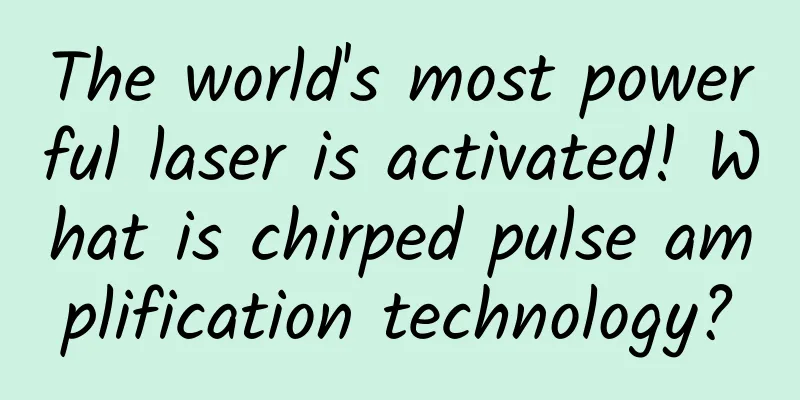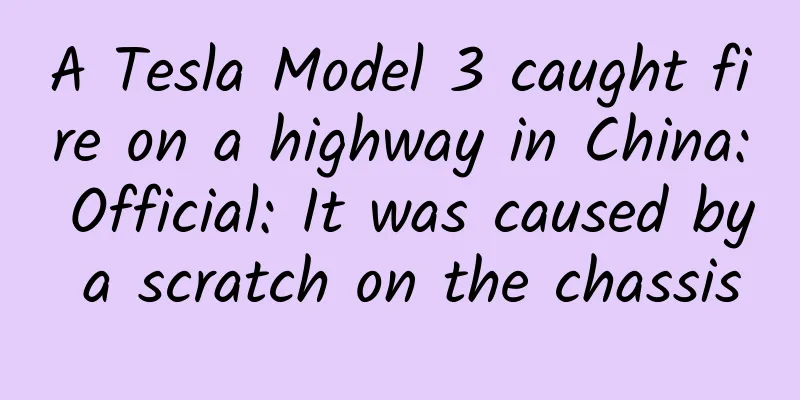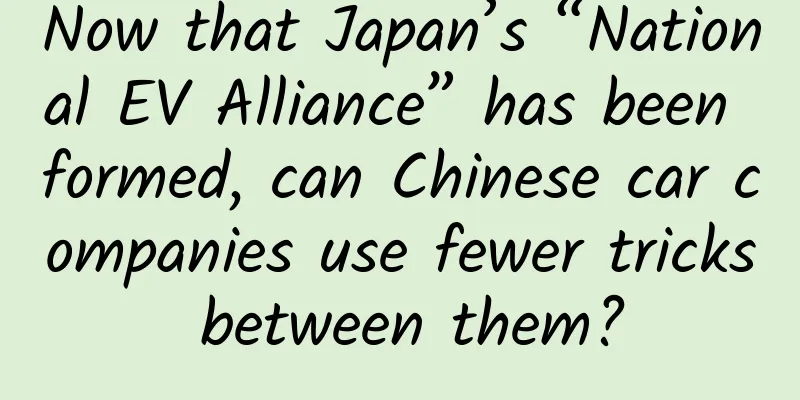The world's most powerful laser is activated! What is chirped pulse amplification technology?

|
The world's most powerful laser is activated! What is chirped pulse amplification technology? Ji Yang In April 2024, a news report said that a high-tech center in Romania recently activated the world's most powerful laser. We have all heard of lasers and know that they are a very powerful light source. The light they emit is laser, which has high intensity, good directionality, and a wide range of applications. However, where is the "world's most powerful" in this news reflected? How is it achieved? Hello everyone, I am Ji Yang, and today I will talk about these things. Something that emits light is a light source, which converts energy into light. For example, a burning candle converts chemical energy into light, the bright sun converts atomic energy into light, and a light-emitting diode converts electrical energy into light. How do we compare the strength of these lights? This requires considering several factors, including the energy of the light, the area of irradiation, and the duration, etc. Consider energy first. The Romanian laser emits pulsed lasers, and the energy of each laser pulse is about 10 joules, which is equivalent to the energy obtained by a large bottle of Coke (about 1 kg) falling from a table 1 meter high to the ground. If it hits your foot, it will feel a little painful, but it is still bearable. Then there is the irradiation area. The same energy applied to different areas will have very different effects. It is the same as pressing a thumbtack with your hand: the force acting on the thumbtack cap is the same as the force acting on the tip of the thumbtack, but your fingers will not be injured and you can press the thumbtack into the board. The light emitted by ordinary light sources goes in all directions, while lasers have good directionality and the energy of light can be concentrated on a very small area, so the intensity (also known as light intensity) is very large. At noon in April, the palm-sized ground receives about 10 joules of sunlight per second, while the beam width of the Romanian laser is only a few millimeters, so their light intensities differ by hundreds of thousands or millions of times. We also need to consider the duration. Energy divided by time is what we usually call power. The same energy released in different time lengths has very different power and effects. For example, Xiao Ming helped an old lady cross the road, and the police kicked the gangster in the buttocks. The total energy they paid may be similar, but the old lady reached the other side of the road safely, while the bad guy was killed directly. Sunlight irradiates evenly and continuously, and pulsed lasers compress limited energy and release it in a very short period of time, so the instantaneous burst effect is even more amazing. Simply put, the strength of a beam of light is measured by dividing the energy of the light by the area of illumination and then by the duration. For the same amount of energy, the smaller the area of illumination and the shorter the duration, the greater the peak power of the light. The Romanian laser can make the laser pulse reach a peak power of 10 petawatts within 1 femtosecond, that is, compressing 10 joules of light energy into a light pulse of 1 femtosecond, which is 1000 trillionths of a second. This is difficult to do, not only because 1 femtosecond is a very short time, but also because the peak power is too large, and no material can withstand it and will be burned. In order to achieve this remarkable achievement, the chirped pulse amplification technology invented by French scientist Mourou in the 1980s must be used to increase the power while ensuring the intensity of the laser. Since the invention of the laser in 1960, scientists have been working hard to improve various indicators of lasers. For pulsed lasers, two important goals are to increase the energy of a single pulse and shorten the pulse width. Through ultrafast laser technologies such as Q-switching, mode locking, and Kerr lens mode locking, scientists can increase laser pulses from the order of milliseconds to the order of nanoseconds, picoseconds, and even femtoseconds. However, to increase the energy of a single pulse laser, it is necessary to amplify the laser pulse in the gain medium (that is, the laser crystal), and this is where the difficulty arises. Ultra-high laser peak power will damage the gain medium. Increasing the diameter of the laser beam will help reduce its peak power, but the effect is not particularly obvious, and it also puts unrealistic requirements on the growth of the laser crystal. Chirped pulse amplification technology came into being. Laser is a quantum phenomenon and must obey the laws of quantum mechanics. According to the uncertainty principle, when the laser pulse is very short, the wavelength of the laser has a certain distribution range. Using gratings or optical fibers, light of different wavelengths can be separated and allowed to reunite after passing through different lengths of paths. This way, the duration of the pulse can be prolonged. Light of different wavelengths, or frequencies, arrives at different times, just like the ebb and flow of a bird's cry, so this phenomenon is called "chirping". A properly designed system can stretch the width of the laser pulse by tens of thousands or even hundreds of thousands of times, from the order of femtoseconds to picoseconds or even nanoseconds. In this process, due to the conservation of energy, the peak energy of the laser pulse will also drop by a corresponding multiple. Of course, the reverse is also possible, compressing nanosecond or picosecond laser pulses to the order of femtoseconds. The working principle of chirped pulse amplification technology is as follows: first, an ultrashort laser pulse with a small energy (this is the seed light) is generated, which is then stretched in time into a wide pulse, and then amplified by a laser crystal. Because the pulse width at this time is large and the peak power is low, the laser crystal will not be damaged even if it is amplified many times. A single pulse can have very high energy, and then the chirp system is applied in reverse to squeeze this laser pulse with high energy but long duration into a very short time, so that a laser pulse with high energy and short duration can be obtained. Chirped laser amplification technology is very important. The Romanian laser is just a typical example. Scientists there have made full use of existing technical means and perhaps invented some new methods to create the shortest and most intense laser pulses to date, compressing 10 joules of light energy into an ultra-short time of 1 femtosecond. There are many countries engaged in research in this area, and some units in my country have also done very good work. With the advancement of laser science and technology, high-intensity ultrashort optical pulses have shown their value in many fields such as particle physics, nuclear physics, and medicine. We hope that it will make more progress and be more widely used in the future. This article is a work supported by Science Popularization China Starry Sky Project Author Name: Ji Yang Reviewer: Zuo Yuhua, Researcher, Institute of Semiconductors, Chinese Academy of Sciences Produced by: China Association for Science and Technology Department of Science Popularization Producer: China Science and Technology Press Co., Ltd., Beijing Zhongke Xinghe Culture Media Co., Ltd. |
<<: Are there bacteria that "eat paper" in nature?
Recommend
The correct way to enjoy the "autumn coolness": first grasp the "personality" of Bailu
Bailu is the fifteenth solar term in the twenty-f...
80% of PS4 players have never seen Drake? Game experience of "Uncharted: Drake Collection"
Since Sony officially announced "Uncharted 4...
Five key trends in the automotive industry in 2025
The automotive industry has always been one of ev...
The first place of "the dirtiest fruit", be careful if you take one bite! Many people like to eat it in summer
With the arrival of hot summer, street fruit cutt...
QQ PC/mobile version big update: group video, one-click mute for all members
On February 9, Tencent made a major upgrade to QQ...
The secret of Toutiao article recommendation mechanism: how to get massive recommendations?
Whether for the sake of money or the platform'...
A woman's splitting headache was actually related to her daily trips to the vegetable market! Doctors: This type of disease has a very high mortality rate
Aunt Mei (pseudonym), 51 years old, from Heyuan, ...
How much does it cost to join the Yichang Photo Mini Program?
How much does it cost to join the Yichang Photo M...
Next-generation console competition: Chinese version of XBOX ONE and PS4 comparison
After Microsoft's XBOX ONE entered China on S...
Didi’s 100 yuan withdrawal and promotional marketing!
Two nights ago, a "wool message" sudden...
Wilson: New Energy Vehicle Industry Monthly Report in June 2023
01. Market performance Overall performance of the...
Hitachi and Panasonic increase investment in autonomous driving technology and enter the automotive field
According to a recent report by Nikkei, Hitachi a...
GAC Aion and Huawei jointly develop smart electric vehicles, with each party investing more than 100 people
At a time when the concept of new energy vehicles...
3 tips for landing page optimization!
The landing page is the most important part of th...
Oracle: New TikTok board will have 4 Americans, possibly including Masayoshi Son
On Wednesday local time, Maria Bartiromo, anchor ...









